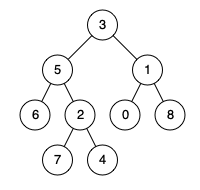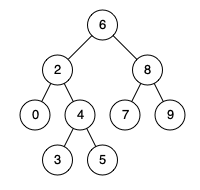142. 环形链表 II
问题描述
给定一个链表的头节点 head ,返回链表开始入环的第一个节点。 如果链表无环,则返回 null。
如果链表中有某个节点,可以通过连续跟踪 next 指针再次到达,则链表中存在环。 为了表示给定链表中的环,评测系统内部使用整数 pos 来表示链表尾连接到链表中的位置(索引从 0 开始)。如果 pos 是 -1,则在该链表中没有环。注意:pos 不作为参数进行传递,仅仅是为了标识链表的实际情况。
不允许修改 链表。
示例 1:

输入:head = [3,2,0,-4], pos = 1
输出:返回索引为 1 的链表节点
解释:链表中有一个环,其尾部连接到第二个节点。
示例 2:

输入:head = [1,2], pos = 0
输出:返回索引为 0 的链表节点
解释:链表中有一个环,其尾部连接到第一个节点。
示例 3:

输入:head = [1], pos = -1
输出:返回 null
解释:链表中没有环。
提示:
- 链表中节点的数目范围在范围
[0, 104]内 -105 <= Node.val <= 105pos的值为-1或者链表中的一个有效索引
**进阶:**你是否可以使用 O(1) 空间解决此题?
解题思路与代码实现
解题思路I:
使用辅助集合存储访问过的节点:
如果有环,第一个遇到的访问过的节点即为入环的第一个节点;
如果无环,返回null;
class Solution {
public ListNode detectCycle(ListNode head) {
ListNode pos = head;
Set<ListNode> visited = new HashSet<ListNode>(); // 记录访问过的节点
while (pos != null) {
if (visited.contains(pos)) {
return pos;
} else {
visited.add(pos);
}
pos = pos.next;
}
return null;
}
}
解题思路II:
- 先判断是否有环,使用快慢指针,初始时
fast和slow都指向head,fast指针每次走两步,slow指针每次走一步; - 如果有环,
fast移到head头结点,然后fast和slow每次都走一步,相遇时返回相遇节点; - 如果无环,则返回null。
public class Solution {
public ListNode detectCycle(ListNode head) {
if(head == null || head.next == null){ // 节点数量小于等于1,不可能有环
return null;
}
// 快慢指针判断是否有环
ListNode slow = head ,fast = head;
while(fast!=null && slow!=null){
slow = slow.next; // slow走一步
fast = fast.next; // fast走两步
if(fast!=null && fast.next != null){
fast = fast.next;
}else{ // fast 指针走过链表末端,说明链表无环,
return null;
}
if(fast == slow){ // 二者指向同一节点
fast = head;
break;
}
}
//有环
while (fast != null){
if (fast == slow ){
return fast;
}
fast = fast.next;
slow = slow.next;
}
return null;
}
}
踩坑点
无
92. 反转链表 II
问题描述
给你单链表的头指针 head 和两个整数 left 和 right ,其中 left <= right 。请你反转从位置 left 到位置 right 的链表节点,返回 反转后的链表 。
示例 1:

输入:head = [1,2,3,4,5], left = 2, right = 4
输出:[1,4,3,2,5]
示例 2:
输入:head = [5], left = 1, right = 1
输出:[5]
提示:
- 链表中节点数目为
n 1 <= n <= 500-500 <= Node.val <= 5001 <= left <= right <= n
进阶: 你可以使用一趟扫描完成反转吗?
解题思路与代码实现
解题思路:
将链表划分为三部分:[1, left)、[left, right]、[right+1, n]
扫描链表,将[left, right]区间的中间链表反转后重新拼接
需要注意特殊的情况导致的NPE,如左链表不存在,右链表不存在
class Solution {
/**
* 反转从位置 left 到位置 right 的链表节点
*/
public ListNode reverseBetween(ListNode head, int left, int right) {
if (head == null || head.next == null) { // 节点数不超过1的链表直接返回
return head;
}
int count = 1; // 计数器
ListNode cur = head; // 辅助指针
ListNode leftHead = head, leftTail = null; // 左链表头尾结点
while (cur != null && count < left) {
leftTail = cur;
cur = cur.next;
count++;
}
if (leftTail != null) { // 左链表不为空
leftTail.next = null;
}
ListNode midHead = cur, midTail = null; // 需要翻转的中间链表头尾结点
while (cur != null && count <= right) {
midTail = cur;
cur = cur.next;
count++;
}
if (midTail != null){
midTail.next = null;
}
ListNode rightHead = cur; // 右链表的头结点
ListNode[] nodes = reverseList(midHead); // 中间链表反转
if ( leftTail == null) {
leftHead = nodes[0];
} else {
leftTail.next = nodes[0];
}
nodes[1].next = rightHead;
return leftHead;
}
/**
* 反转链表,返回值包含反转后新链表的头尾节点
*/
private ListNode[] reverseList(ListNode head) {
ListNode newTail = head, newHead = null; // 新链表的头尾节点
ListNode current = head, post = null; // 辅助指针
while (current != null) {
post = current.next;
current.next = newHead;
newHead = current;
current = post;
}
return new ListNode[]{newHead, newTail};
}
}
踩坑点
NPE
146. LRU 缓存
问题描述
请你设计并实现一个满足 LRU (最近最少使用) 缓存 约束的数据结构。
实现 LRUCache 类:
LRUCache(int capacity)以 正整数 作为容量capacity初始化 LRU 缓存int get(int key)如果关键字key存在于缓存中,则返回关键字的值,否则返回-1。void put(int key, int value)如果关键字key已经存在,则变更其数据值value;如果不存在,则向缓存中插入该组key-value。如果插入操作导致关键字数量超过capacity,则应该 逐出 最久未使用的关键字。
函数 get 和 put 必须以 O(1) 的平均时间复杂度运行。
示例:
输入
["LRUCache", "put", "put", "get", "put", "get", "put", "get", "get", "get"]
[[2], [1, 1], [2, 2], [1], [3, 3], [2], [4, 4], [1], [3], [4]]
输出
[null, null, null, 1, null, -1, null, -1, 3, 4]
解释
LRUCache lRUCache = new LRUCache(2);
lRUCache.put(1, 1); // 缓存是 {1=1}
lRUCache.put(2, 2); // 缓存是 {1=1, 2=2}
lRUCache.get(1); // 返回 1
lRUCache.put(3, 3); // 该操作会使得关键字 2 作废,缓存是 {1=1, 3=3}
lRUCache.get(2); // 返回 -1 (未找到)
lRUCache.put(4, 4); // 该操作会使得关键字 1 作废,缓存是 {4=4, 3=3}
lRUCache.get(1); // 返回 -1 (未找到)
lRUCache.get(3); // 返回 3
lRUCache.get(4); // 返回 4
提示:
1 <= capacity <= 30000 <= key <= 100000 <= value <= 105- 最多调用
2 * 105次get和put
解题思路与代码实现
解题思路:
使用哈希表缓存键值对,使用双端队列实现LRU(最近最少使用)算法,最近最少访问的key放在队头,最新访问的key放在队尾。
调用get方法:若key存在,将key从双端队列中移除并重新添加到队尾;
调用put方法:
若key存在,更新value,同时将key从双端队列中移除并重新添加到队尾;
若key不存在:
如果缓存未满,直接插入到缓存中并将key保存到双端队列的队尾;
如果缓存已满,先从队头移除一个旧key,同时移除缓存;然后将新的key-value添加到缓存,并将key保存到双端队列的队尾。
class LRUCache {
private HashMap<Integer, Integer> map = null; // 存储键值对
private int capacity = 0; // 缓存容量
private Deque<Integer> deque = null; // 辅助双端队列,实现lru算法,淘汰先入队的
public LRUCache(int capacity) {
this.capacity = capacity;
map = new HashMap<>(capacity);
deque = new LinkedList<>();
}
/**
* 如果关键字 key 存在于缓存中,则返回关键字的值,否则返回 -1
*
* @param key 关键字key
*/
public int get(int key) {
if (map.containsKey(key)) {
// key被访问,调整其在队列中的位置
deque.remove(key);
deque.addLast(key);
return map.get(key);
}
return -1;
}
/**
* 如果关键字 key 已经存在,则变更其数据值 value ;如果不存在,则向缓存中插入该组 key-value 。
* 如果插入操作导致关键字数量超过 capacity ,则应该 逐出 最久未使用的关键字。
*
* @param key 关键字
* @param value 关键字对应的值
*/
public void put(int key, int value) {
// 如果关键字 key 已经存在,则变更其数据值 value
if (map.containsKey(key)) {
// 更新原有key在队列中的位置
deque.remove(key);
} else if (map.size() == capacity) { // key不存在且容量不充足
// 找到最久未使用的关键字key移除
Integer oldKey = deque.removeFirst();
map.remove(oldKey);
}
// 入队
deque.addLast(key);
// 存在则更新,不存在则加入
map.put(key, value);
}
}
/**
* Your LRUCache object will be instantiated and called as such:
* LRUCache obj = new LRUCache(capacity);
* int param_1 = obj.get(key);
* obj.put(key,value);
*/
踩坑点
236. 二叉树的最近公共祖先
问题描述
给定一个二叉树, 找到该树中两个指定节点的最近公共祖先。
百度百科中最近公共祖先的定义为:“对于有根树 T 的两个节点 p、q,最近公共祖先表示为一个节点 x,满足 x 是 p、q 的祖先且 x 的深度尽可能大(一个节点也可以是它自己的祖先)。”
示例 1:

输入:root = [3,5,1,6,2,0,8,null,null,7,4], p = 5, q = 1
输出:3
解释:节点 5 和节点 1 的最近公共祖先是节点 3 。
示例 2:

输入:root = [3,5,1,6,2,0,8,null,null,7,4], p = 5, q = 4
输出:5
解释:节点 5 和节点 4 的最近公共祖先是节点 5 。因为根据定义最近公共祖先节点可以为节点本身。
示例 3:
输入:root = [1,2], p = 1, q = 2
输出:1
提示:
- 树中节点数目在范围
[2, 105]内。 -109 <= Node.val <= 109- 所有
Node.val互不相同。 p != qp和q均存在于给定的二叉树中。
解题思路与代码实现
解题思路:
解题思路是通过递归后序遍历二叉树,查找节点 p 和 q 的最近公共祖先。如果当前节点为 null 或者是 p 或 q 中的一个,直接返回当前节点。递归地在左右子树中查找 p 和 q,并根据返回结果判断:
- 如果左子树返回
null,右子树返回null,则p和q不在当前树中,返回null。 - 如果左子树返回非
null,右子树返回null,则p和q都在左子树中,返回左子树的结果。 - 如果左子树返回
null,右子树返回非null,则p和q都在右子树中,返回右子树的结果。 - 如果左右子树分别返回非
null,则当前节点即为p和q的最近公共祖先,返回当前节点。
class Solution {
/**
* 返回p、q在root树中的最近公共祖先
*/
public TreeNode lowestCommonAncestor(TreeNode root, TreeNode p, TreeNode q) {
// 当root为null或者p、q之一为root时,返回root
if (root == null || root == p || root == q) {
return root;
}
// 后序遍历
TreeNode left = lowestCommonAncestor(root.left, p, q);
TreeNode right = lowestCommonAncestor(root.right, p, q);
if (left == null && right == null) { // p或q不在root树中
return null;
} else if (left == null) { // 在右子树中找到了p、q
return right;
} else if (right == null) { // 左子树中找到了p、q
return left;
} else { // p、q分别在左右子树中
return root;
}
}
}
踩坑点
124. 二叉树中的最大路径和
问题描述
二叉树中的 路径 被定义为一条节点序列,序列中每对相邻节点之间都存在一条边。同一个节点在一条路径序列中 至多出现一次 。该路径 至少包含一个 节点,且不一定经过根节点。
路径和 是路径中各节点值的总和。
给你一个二叉树的根节点 root ,返回其 最大路径和 。
示例 1:

输入:root = [1,2,3]
输出:6
解释:最优路径是 2 -> 1 -> 3 ,路径和为 2 + 1 + 3 = 6
示例 2:

输入:root = [-10,9,20,null,null,15,7]
输出:42
解释:最优路径是 15 -> 20 -> 7 ,路径和为 15 + 20 + 7 = 42
提示:
- 树中节点数目范围是
[1, 3 * 104] -1000 <= Node.val <= 1000
解题思路与代码实现
解题思路:
通过递归后序遍历二叉树来求解节点及其子树的最大路径和。
在递归过程中,空节点视为0,对于每个节点,计算其左右子树的最大路径和(如果为负数则视作0),然后更新全局变量 res,记录可能的最大路径和,最后返回以当前节点为根的子树中包含当前节点的最大路径和。
class Solution {
private int res = Integer.MIN_VALUE; // 记录全局最大路径和
/**
* 返回以root为根节点的子树中的最大路径和
* @param root 当前节点
* @return 当前节点及其子树的最大路径和
*/
public int maxPathSum(TreeNode root) {
postOrder(root); // 调用后序遍历函数
return res; // 返回最大路径和
}
/**
* 后序遍历递归函数,计算以当前节点为根的子树的最大路径和
* @param root 当前节点
* @return 当前节点及其子树的最大贡献值(即单侧最大路径和)
*/
private int postOrder(TreeNode root) {
if (root == null) { // 如果当前节点为空,返回0
return 0;
}
// 计算左右子树的最大贡献值,小于0的贡献值视为0
int leftVal = Math.max(0, postOrder(root.left));
int rightVal = Math.max(0, postOrder(root.right));
// 更新全局最大路径和
res = Math.max(res, leftVal + rightVal + root.val);
// 返回当前节点及其子树的最大贡献值(单侧最大路径和)
return root.val + Math.max(leftVal, rightVal);
}
}
踩坑点
373. 查找和最小的 K 对数字
问题描述
给定两个以 非递减顺序排列 的整数数组 nums1 和 nums2 , 以及一个整数 k 。
定义一对值 (u,v),其中第一个元素来自 nums1,第二个元素来自 nums2 。
请找到和最小的 k 个数对 (u1,v1), (u2,v2) … (uk,vk) 。
示例 1:
输入: nums1 = [1,7,11], nums2 = [2,4,6], k = 3
输出: [1,2],[1,4],[1,6]
解释: 返回序列中的前 3 对数:
[1,2],[1,4],[1,6],[7,2],[7,4],[11,2],[7,6],[11,4],[11,6]
示例 2:
输入: nums1 = [1,1,2], nums2 = [1,2,3], k = 2
输出: [1,1],[1,1]
解释: 返回序列中的前 2 对数:
[1,1],[1,1],[1,2],[2,1],[1,2],[2,2],[1,3],[1,3],[2,3]
提示:
1 <= nums1.length, nums2.length <= 105-109 <= nums1[i], nums2[i] <= 109nums1和nums2均为 升序排列1 <= k <= 104k <= nums1.length * nums2.length
解题思路与代码实现
解题思路:
初始时将所有的 (i,0) 对入堆,这是因为 (i,0) 对应的数对是数组 nums1 的前 k 个元素与 nums2 的第一个元素的和,这些是最小的数对之一。
在每次从堆中取出数对 (i,j) 后,将 (i,j+1) 入堆。这是因为 (i,j+1) 对应的数对是数组 nums1[i] 和 nums2[j+1] 的和,可能成为下一个可能的最小数对。这样做可以保证堆中始终是当前可能的最小数对集合,确保了答案的正确性和最小性。
class Solution {
/**
* 返回两个数组 nums1 和 nums2 中前 k 个最小的数对
* @param nums1 第一个数组
* @param nums2 第二个数组
* @param k 最小数对的个数
* @return 前 k 个最小数对的列表
*/
public List<List<Integer>> kSmallestPairs(int[] nums1, int[] nums2, int k) {
List<List<Integer>> ans = new ArrayList<>(k); // 预分配空间
PriorityQueue<int[]> pq = new PriorityQueue<>((a, b) -> a[0] - b[0]); // 小顶堆
// 初始将所有 (i,0) 入堆,其中 i 为 0 到 nums1.length - 1
for (int i = 0; i < Math.min(nums1.length, k); i++) {
pq.add(new int[] { nums1[i] + nums2[0], i, 0 });
}
// 依次取出堆中最小的数对,加入结果列表,同时将其下一个数对 (i, j+1) 入堆
while (ans.size() < k && !pq.isEmpty()) {
int[] p = pq.poll(); // 取出当前最小的数对
int i = p[1];
int j = p[2];
ans.add(List.of(nums1[i], nums2[j])); // 加入结果列表
// 如果 nums2 中仍有下一个元素,将其与 nums1[i] 的和入堆
if (j + 1 < nums2.length) {
pq.add(new int[] { nums1[i] + nums2[j + 1], i, j + 1 });
}
}
return ans; // 返回前 k 个最小数对的列表
}
}
踩坑点
暴力枚举所有组合导致超时
530. 二叉搜索树的最小绝对差
问题描述
给你一个二叉搜索树的根节点 root ,返回 树中任意两不同节点值之间的最小差值 。
差值是一个正数,其数值等于两值之差的绝对值。
示例 1:

输入:root = [4,2,6,1,3]
输出:1
示例 2:

输入:root = [1,0,48,null,null,12,49]
输出:1
提示:
- 树中节点的数目范围是
[2, 104] 0 <= Node.val <= 105
解题思路与代码实现
解题思路:
二叉搜索树的性质,中序遍历的数组是升序排列的。
所以最小绝对值差必然在|根节点值-左子树最大值| 和|根节点值-右子树最小值|,在中序遍历数组中它们三者是相邻的。
public int getMinimumDifference(TreeNode root) {
int res = Integer.MAX_VALUE; // 初始化最小绝对差为最大整数
Integer pre = null; // 用于记录中序遍历时前一个节点的值
// 非递归中序遍历二叉搜索树
Stack<TreeNode> stack = new Stack<>(); // 辅助栈
TreeNode cur = root; // 辅助指针
while (cur != null || !stack.isEmpty()) {
if (cur != null) {
stack.push(cur);
cur = cur.left; // 往左子树遍历
} else {
TreeNode node = stack.pop(); // 弹出栈顶节点
if (pre != null) {
res = Math.min(res, Math.abs(pre - node.val)); // 更新最小绝对差
}
pre = node.val; // 更新前一个节点的值为当前节点的值
cur = node.right; // 遍历右子树
}
}
return res;
}














































